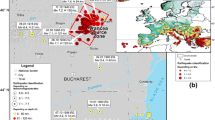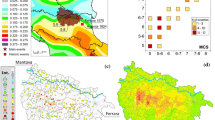Abstract
The Egyptian economy and culture are centralized in the Greater Cairo region. Thus, it is essential that the built environment is able to withstand the possible earthquake events that may occur, and to continue to operate and function. Failure to do so would result in significant economic losses. This study presents the latter stages of a multi-tiered probabilistic earthquake loss estimation model for Greater Cairo and builds upon previous studies of the seismic hazard. In order to assess possible damage to the built environment, and the resulting economic losses, the vulnerability of the built environment is first evaluated. Through the use of satellite images, Egypts building census, previous studies and field surveys, a building-stock inventory is compiled. This building inventory is classified according to structural type and height, and is geocoded by district. Using existing fragility curves, the vulnerability of the building stock is assessed. In addition, the vulnerability of both the electricity and natural gas networks are assessed, through the use of fragility curves, cut sets and an evaluation of the supply networks. Based on the assessment of direct losses, the losses associated with building damage far exceed those associated with the considered network infrastructure. A macro-economic model is developed that takes into account damage to the built environment and provides estimates of indirect economic losses, as well as enabling the identification of the optimal recovery process. Using this model, it is shown that the indirect losses can exceed direct losses for extreme scenarios where the economy is brought to a near standstill. The framework developed and presented herein can be extended to include more networks, and is also applicable to other regions.

















Similar content being viewed by others
References
Abrahamson NA, Silva WJ (2008) Summary of the Abrahamson & Silva NGA ground-motion relations. Earthq Spectr 24(1):67–97
Akkar S. Bommer JJ (2010) Empirical equations for the prediction of PGA, PGV and spectral accelerations in Europe, the Mediterranean region and the middle east. Seismol Res Lett 81(2):5–26
Anagnos T (2001) Development of an electrical substation equipment performance database for evaluation of equipment fragilities. Report for pacific gas and electric and pacific earthquake engineering centre
Assaad R (1993) Formal and informal institutions in the labour market, with applications to the construction sector in Egypt. World Dev 26(6):925–939
Bockarjova M (2004) The direct estimation of the event matrix in the input-output framework in the case of a matrix catastrophe. Conference on input-output and general equilibrium, Brussels, Belgium 2(4)
Boisvert R (1992) Indirect losses from a catastrophic earthquake and the local, regional and national interest. Indirect economic consequences of a catastrophic earthquake. FEMA, Washington
Boore DM, Atkinson GM (2008) Ground-motion prediction equations for the average horizontal component of PGA, PGV, and 5%-damped PSA at spectral periods between 0.01s and 10.0s. Earthq Spectr 24(1):99–138
Bourque PJ, Conway RS (1977) The 1972 Washington input-output study. Graduate School of Business Administration, University of Washington, Seattle
Brookshire DS, Chang SE, Cochrane H, Olson RA, Rose A, Steenson J (1997) Direct and indirect losses from earthquake damage. Earthq Spectra 13(4):683–701
Burrus RT Jr, Dumas CF, Farrell CH, Hall WW Jr (2002) Impact of low intensity hurricanes on regional economic activity. Nat Hazard Rev 3(3):118–125
CAPMAS (1998) Egyptian National Building Census. Central Agency for Public Mobilization and Statistics
CAPMAS (2004) Egyptian Input-Output Table. Central Agency for Public Mobilization and Statistics
CAPMAS (2006) Egyptian National Census. Central Agency for Public Mobilization and Statistics
CAPMAS (2010) Egyptian Census. Central Agency for Public Mobilization and Statistics
CAPMAS (2011) Report on tourism loss during the month of February 2011. Central Agency for Public Mobilization and Statistics
Crowley H, Bommer JJ, Pinho R, Bird JF (2005) The impact of epistemic uncertainty on an earthquake loss model. Earthq Eng Struct Dyn 34(14):1653–1685
Dorra EM (2011) Greater Cairo earthquake loss assessment and its implications on the Egyptian economy, PhD Thesis. Imperial College London
EGAS (2007) Environmental and social impact assessment framework for Greater Cairo natural gas connections project. Egyptian Natural Gas Holding Company Report
EGAS (2010) Local distribution of natural gas in Egypt. Egyptian Natural Gas Holding Company
Federal Emergency Management Agency, FEMA (2003) Instructional material complementing FEMA 451. Design examples, Washington
Gordon P, Richardson HW, Davis B (1996) The business interruption effects of the Northridge earthquake. Lusk Centre Research Institute, University of Southern California, Los Angeles
Hallegatte S (2008) An adaptive regional input-output model and its application to the assessment of the economic cost of Katrina. Risk Anal 28(3):779–799
Ismail A (2009) Private equity and venture capital in emerging markets: a case study of Egypt and the MENA region, PhD Thesis. Massachusetts Institute of Technology
Jayaram N, Baker JW (2010) Efficient sampling and data reduction techniques for probabilistic seismic lifeline risk assessment. Earthq Eng Struct Dyn 39(10):1109–1131
Korkor H (2007) Egyptian natural gas industry development. United Nations Economic Commission for Europe, Geneva
Leontief W (1966) Input-output economics. Oxford University Press, New York
Ministry of Electricity and Energy (2009) Electricity extension report. Egypt
Ministry of Petroleum (2010) MOP (2010) Natural Gas in Egypt. Report, Ministry of Petroleum
Moharram A (2006) Earthquake loss estimation and structural vulnerability assessment for Greater Cairo, PhD Thesis. Imperial College London
Moharram A, Elghazouli AY, Bommer JJ (2008) A framework for a seismic risk model for Greater Cairo. Soil Dyn Earthq Eng 28(10–11):795–811
Mohieldin M, Nasr S (2006) On bank privatisation: the case of Egypt. Q Rev Econ Finance 46(5):707–725
Pineda O, Ordaz M (2003) Seismic vulnerability function for high-diameter buried pipelines: Mexico City’s primary water system case. New Pipeline Technol Secur Saf ASCE 2:1145–1154
Pineda O, Ordaz M (2007) A new seismic intensity parameter to estimate damage in buried pipelines due to seismic wave propagation. J Earthq Eng 11:773–786
Rose A (1995) Input-output economics and computable general equilibrium models. Struct Chang Econ Dyn 6:295–304
Rose A, Lim D (2002) Business interruption losses from natural hazards: conceptual and methodological issues in the case of the Northridge earthquake. Environ Hazards 4:1–14
Rose A, Benavides J, Chang SE, Szczesniak P, Lim D (1997) The regional economic impact of an earthquake: direct and indirect effects of electricity lifeline disruptions. J Reg Sci 37(3):437–458
Rose A, Oladosu G, Liao S (2007) Regional economic impacts of a terrorist attack on the water system of Los Angeles: a computable general disequilibrium analysis. Economic costs and consequences of a terrorist attack. Edward Elgar, Cheltenham
Saadeghvaziri MA, Feng MQ (2001) Experimental and analytical study of base-isolation for electric power equipment. Research progress and accomplishments 2000–2001. Multidisciplinary center for earthquake engineering research
Shinozuka M, Dong X, Chen TC, Jin X (2007) Seismic performance of electric transmission network under component failure. Earthq Eng Struct Dyn 36(2):227–244
Shoven J, Whalley J (1992) Applying general equilibrium. Cambridge University Press, New York
Song, J, Kang WH (2007) Matrix-based system reliability method and applications to structural systems. In: Proceedings of the 18th ASCE engineering mechanics division conference, Blacksburg, VA, USA
Song J, Ok SY (2010) Multi-scale system reliability analysis of lifeline networks under earthquake hazard. Earthq Eng Struct Dyn 39(3):259–279
Tatano H, Tsuchiya S (2008) A framework for economic loss estimation due to seismic transportation network disruption: a spatial computable general equilibrium approach. Nat Hazards 44:253–265
Torres-Vera MA, Canas JA (2003) A lifeline vulnerability study in Barcelona, Spain. Reliab Eng Syst Saf 80:205–210
USDOE (2011) Natural gas pipeline compressor stations. U.S. Department of Energy, Midwest Clean Energy Application Center
World Bank (2011) Arab Republic of Egypt Data. http://data.worldbank.org/country/egypt-arab-republic
Acknowledgments
The authors would like to acknowledge the support and information provided by Dr. Ahmed Moharram and the Ministries of Electricity, Housing and Petroleum in Egypt. The second author would like to acknowledge the generous support of the Willis Research Network. The article has benefitted from the comments of two anonymous reviewers and we would like to acknowledge their contribution to improving the work.
Author information
Authors and Affiliations
Corresponding author
Rights and permissions
About this article
Cite this article
Dorra, E.M., Stafford, P.J. & Elghazouli, A.Y. Earthquake loss estimation for Greater Cairo and the national economic implications. Bull Earthquake Eng 11, 1217–1257 (2013). https://doi.org/10.1007/s10518-013-9426-7
Received:
Accepted:
Published:
Issue Date:
DOI: https://doi.org/10.1007/s10518-013-9426-7




